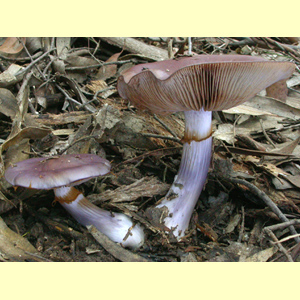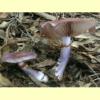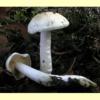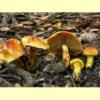



_AH_35_sml.jpg)
Bougher, N.L. & Syme, K. (1998), Fungi of Southern Australia. University of Western Australia Press, Nedlands. [Description, Illustration and Microcharacters of C. archeri, C. erythraceus, C. rotundisporus and C. sinapicolor]
Fuhrer, B. (2005), A Field Guide to Australian Fungi. Bloomings Books, Hawthorn. [Description and Illustration of C. aff. alboviolaceus, C. archeri, C. austroalbidus, C. erythraeus, C. rotundisporus and C. sinapicolor]
Gasparini, B. (2007b), Genus Cortinarius, subgenus Phlegmacium in Tasmania, New Zealand J. Bot. 45: 155–236 [Description, B&W Illustration and Microcharacters of some species that morphologically belong to subgenus Myxacium: C. archeri, C. austroalbidus, C. austrocausticus, C. elatostipitatus, C. lacteus, C. madidus, C. pseudorotundisporus, C. quaresimalis, C. rotundisporus, C. sinapicolor and C. submagellanicus]
Gasparini, B. & Soop, K. (2008), Contribution to the knowledge of Cortinarius [Agaricales, Cortinariaceae] of Tasmania (Australia) and New Zealand, Australas. Mycol. 27: 173–203. [Description, Microcharacters and Illustration of C. pseudorotundisporus]
Grey, P. & Grey, E. (2005), Fungi Down Under. Fungimap, South Yarra. [Description, Illustration and Map for C. austroalbidus and C. rotundisporus]
Grgurinovic, C.A. (1997a), Larger Fungi of South Australia. The Botanic Gardens of Adelaide and State Herbarium and The Flora and Fauna of South Australia Handbooks Committee, Adelaide. [Key to South Australian species, and Description and Microcharacters of C. archeri, C. austroalbidus, C. bundarus, C. erythraeus, C. fiveashianus, C. microarcheri, C. sinapicolor, C. rotundisporus (also as C. austroevernius and C. oleaginus), C. subarcheri and C. subarvinaceus, and Illustration of C. archeri, C. erythraeus, C. fiveashianus and C. rotundisporus (and as C. austroevernius and C. oleaginus)]
Horak, E. & Wood, A.E. (1990), Cortinarius Fr. (Agaricales) in Australasia. 1. Subgen. Myxacium and subgen. Paramyxacium, Sydowia 42: 88–168. [Description, B&W Illustration and Microcharacters of C. archeri, C. erythraeus, C. microarcheri, C. rotundisporus and C. sinapicolor, and Description, B&W Illustration and Microcharacters of C. austroalbidus, C. ochraceus, C. subarcheri (considered a 'doubtful' species) and C. subarvinaceus]
McCann, I.R. (2003), Australian Fungi Illustrated. Macdown Productions, Vermont. [Illustration of C. aff. alboviolaceus, C. archeri, C. austroalbidus, C. erythraeus, C. rotundisporus and C. sinapicolor]
Young, A.M. (2005b), A Field Guide to the Fungi of Australia. University of New South Wales Press, Sydney. [Illustration and Description of C. archeri]
